In communications and information processing, code is a system of rules to convert information—such as a letter, word, sound, image, or gesture—into another form, sometimes shortened or secret, for communication through a communication channel or storage in a storage medium. An early example is an invention of language, which enabled a person, through speech, to communicate what they thought, saw, heard, or felt to others. But speech limits the range of communication to the distance a voice can carry and limits the audience to those present when the speech is uttered. The invention of writing, which converted spoken language into visual symbols, extended the range of communication across space and time.

In cryptography, a cipher is an algorithm for performing encryption or decryption—a series of well-defined steps that can be followed as a procedure. An alternative, less common term is encipherment. To encipher or encode is to convert information into cipher or code. In common parlance, "cipher" is synonymous with "code", as they are both a set of steps that encrypt a message; however, the concepts are distinct in cryptography, especially classical cryptography.

An electrical telegraph was a point-to-point text messaging system, primarily used from the 1840s until the late 20th century. It was the first electrical telecommunications system and the most widely used of a number of early messaging systems called telegraphs, that were devised to communicate text messages more rapidly than by physical transportation. Electrical telegraphy can be considered to be the first example of electrical engineering.
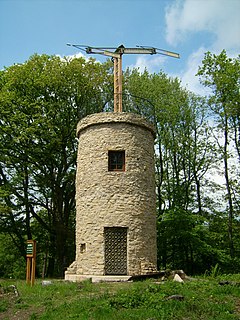
Telegraphy is the long-distance transmission of messages where the sender uses symbolic codes, known to the recipient, rather than a physical exchange of an object bearing the message. Thus flag semaphore is a method of telegraphy, whereas pigeon post is not. Ancient signalling systems, although sometimes quite extensive and sophisticated as in China, were generally not capable of transmitting arbitrary text messages. Possible messages were fixed and predetermined and such systems are thus not true telegraphs.

Wireless telegraphy or radiotelegraphy is transmission of text messages by radio waves, analogous to electrical telegraphy using cables. Before about 1910, the term wireless telegraphy was also used for other experimental technologies for transmitting telegraph signals without wires. In radiotelegraphy, information is transmitted by pulses of radio waves of two different lengths called "dots" and "dashes", which spell out text messages, usually in Morse code. In a manual system, the sending operator taps on a switch called a telegraph key which turns the transmitter on and off, producing the pulses of radio waves. At the receiver the pulses are audible in the receiver's speaker as beeps, which are translated back to text by an operator who knows Morse code.
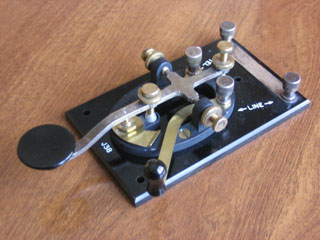
A telegraph key is a specialized electrical switch used by a trained operator to transmit text messages in Morse code in a telegraphy system. Keys are used in all forms of electrical telegraph systems, including landline telegraphy and "wireless" and radio telegraphy. An operator uses the telegraph key to send electrical pulses of two different lengths: short pulses, called dots or dits, and longer pulses, called dashes or dahs. These pulses encode the letters and other characters that spell out the message.
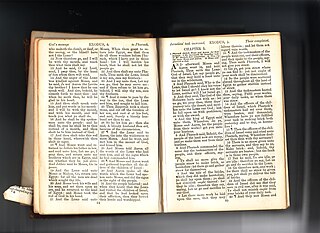
A book cipher, or Ottendorf cipher, is a cipher in which the key is some aspect of a book or other piece of text. Books, being common and widely available in modern times, are more convenient for this use than objects made specifically for cryptographic purposes. It is typically essential that both correspondents not only have the same book, but the same edition.
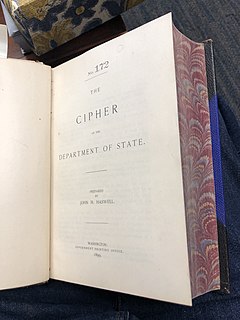
A codebook is a type of document used for gathering and storing cryptography codes. Originally codebooks were often literally books, but today codebook is a byword for the complete record of a series of codes, regardless of physical format.
A telegraph code is one of the character encodings used to transmit information by telegraphy. Morse code is the best-known such code. Telegraphy usually refers to the electrical telegraph, but telegraph systems using the optical telegraph were in use before that. A code consists of a number of code points, each corresponding to a letter of the alphabet, a numeral, or some other character. In codes intended for machines rather than humans, code points for control characters, such as carriage return, are required to control the operation of the mechanism. Each code point is made up of a number of elements arranged in a unique way for that character. There are usually two types of element, but more element types were employed in some codes not intended for machines. For instance, American Morse code had about five elements, rather than the two of International Morse Code.

In cryptology, a code is a method used to encrypt a message that operates at the level of meaning; that is, words or phrases are converted into something else. A code might transform "change" into "CVGDK" or "cocktail lounge". The U.S. National Security Agency defined a code as "A substitution cryptosystem in which the plaintext elements are primarily words, phrases, or sentences, and the code equivalents typically consist of letters or digits in otherwise meaningless combinations of identical length." A codebook is needed to encrypt, and decrypt the phrases or words.

The Phillips Code is a brevity code (shorthand) created in 1879 by Walter P. Phillips for the rapid transmission of press reports by telegraph. It defined hundreds of abbreviations and initialisms for commonly used words that news authors and copy desk staff would commonly use. There were subcodes for commodities and stocks called the Market Code, a Baseball Supplement, and single-letter codes for Option Months. The last official edition was published in 1925, but there was also a Market supplement last published in 1909 that was separate.
The Chinese telegraph code, Chinese telegraphic code, or Chinese commercial code is a four-digit decimal code for electrically telegraphing messages written with Chinese characters.
With the rise of easily-intercepted wireless telegraphy, codes and ciphers were used extensively in World War I. The decoding by British Naval intelligence of the Zimmermann telegram helped bring the United States into the war.

Telegram style, telegraph style, telegraphic style, or telegraphese is a clipped way of writing which abbreviates words and packs information into the smallest possible number of words or characters. It originated in the telegraph age when telecommunication consisted only of short messages transmitted by hand over the telegraph wire. The telegraph companies charged for their service by the number of words in a message, with a maximum of 15 characters per word for a plain-language telegram, and 10 per word for one written in code. The style developed to minimize costs but still convey the message clearly and unambiguously.
A wire signal is a brevity code used by telegraphers to save time and cost when sending long messages. The most well-known of these was the 92 Code adopted by Western Union in 1859. The reason for this adoption was to reduce bandwidth usage over the telegraph lines and speed transmissions by utilizing a numerical code system for various frequently used phrases.

In the history of cryptography, 91-shiki ōbun injiki or Angōki Taipu-A, codenamed Red by the United States, was a diplomatic cryptographic machine used by the Japanese Foreign Office before and during World War II. A relatively simple device, it was quickly broken by western cryptographers. The Red cipher was succeeded by the Type B "Purple" machine which used some of the same principles. Parallel usage of the two systems assisted in the breaking of the Purple system.
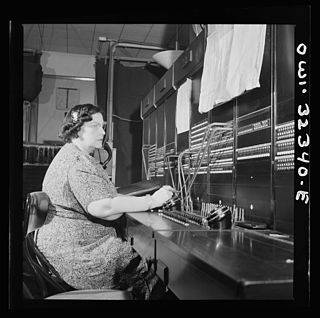
Women in telegraphy have been evident since the 1840s. The introduction of practical systems of telegraphy in the 1840s led to the creation of a new occupational category, the telegrapher, telegraphist or telegraph operator. Duties of the telegrapher included sending and receiving telegraphic messages, known as telegrams, using a variety of signaling systems, and routing of trains for the railroads. While telegraphy is often viewed as a males-only occupation, women were also employed as telegraph operators from its earliest days. Telegraphy was one of the first communications technology occupations open to women.
Acme Commodity and Phrase Code is a codebook providing the general-purpose commercial telegraph code known as the Acme Code. It was published in 1923 by the Acme Code Company. The book provides a listing of condensed terms and codes used to shorten telegrams and save money. The book was extremely popular amongst businesses in the 1930s. This code was one of the few telegram codes permitted by the Allied powers during the Second World War.
Australian railway telegraphic codes were devised to reduce the size of telegraphic messages, though some survived into the telephone era. They were used in telegrams between various parts of the railway system, such as offices, stations, locomotive depots and goods yards.

In the nineteenth century, the United Kingdom had the world's first commercial telegraph company. British telegraphy dominated international telecommunications well into the twentieth. Telegraphy is the sending of textual messages by human operators using symbolic codes. Electrical telegraphy used conducting wires to send messages, often incorporating a telegram service to deliver the telegraphed communication from the telegraph office. This is distinct from optical telegraphy that preceded it and the radiotelegraphy that followed. Though Francis Ronalds first demonstrated a working telegraph over a substantial distance in 1816, he was unable to put it into practical use. Starting in 1836, William Fothergill Cooke, with the scientific assistance of Charles Wheatstone, developed the Cooke and Wheatstone telegraph. The needle telegraph instrument suggested by Wheatstone, the battery invented by John Frederic Daniell, and the relay invented by Edward Davy were important components of this system.













